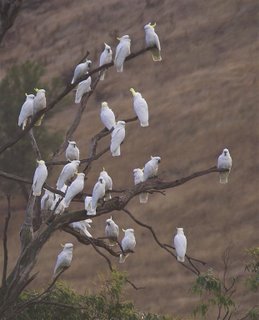 That was the name John Gould called the bird that most of us call simply "Sulphur-crested" and arguably, after the Kookaburra, the most widely known Australian bird. On my recent trip "In Search of Cattle Egrets", the most commonly seen bird was undoubtably these Cockatoos, and when you are looking for white birds in paddocks (egrets), they can make for a frustrating search! Gould mentions the farmers dislike of these birds (he's writing in the 1860s) and comments "it is consequently hunted and shot down wherever it is found, a circumstance which tends to lessen its numbers." One imagines it would!!
That was the name John Gould called the bird that most of us call simply "Sulphur-crested" and arguably, after the Kookaburra, the most widely known Australian bird. On my recent trip "In Search of Cattle Egrets", the most commonly seen bird was undoubtably these Cockatoos, and when you are looking for white birds in paddocks (egrets), they can make for a frustrating search! Gould mentions the farmers dislike of these birds (he's writing in the 1860s) and comments "it is consequently hunted and shot down wherever it is found, a circumstance which tends to lessen its numbers." One imagines it would!!I found large flocks in the Broadmarsh and Meadowbank area, but the biggest flock appears to be in the Ouse area. I set off from Ouse on the Osterly Rd., looking for egrets, and shortly came across a large 'cloud' of Cockatoos rising above the trees and calling noisily. I assumed they had been disturbed by farming operations, but as I turned back towards Ouse, I saw the 'culprit'--a Wedgetailed Eagle, just close enough to
 photograph. All the Cockatoos stayed in the trees until the Eagle had disappeared into the distance. The flock here appears to number at least 800 birds, and the other 2 flocks mentioned,are in the 2-300 range. Coincidentally, I came across another Wedgie in the Meadowbank area, on the way back. Although I've watched many Wedgetails over the years, I still stop and watch these magnificent flyers whenever possible.
photograph. All the Cockatoos stayed in the trees until the Eagle had disappeared into the distance. The flock here appears to number at least 800 birds, and the other 2 flocks mentioned,are in the 2-300 range. Coincidentally, I came across another Wedgie in the Meadowbank area, on the way back. Although I've watched many Wedgetails over the years, I still stop and watch these magnificent flyers whenever possible.
6 comments:
Alan,
There certainnly seem to be a lot of Sulfur-crested Cockatoos about at the moment, in all sorts of areas - though I haven't seen flocks of 800!
Your Eagle seems very light - is it a pale morph, or just the angle of the light?
Hi John, your e-mail arrived as I was mulling over how light the Wedgie was.My believe is that it's most probably an immature, probably in its first year, but I'm no expert! If you look closely at it, it has very patchy plumage. On first seeing it. The other bird mentioned was quite dark and presumably an adult.
It may be just a strangely coloured Eagle. I once saw an albino pied butcherbird in northern NSW, and a Pacific Gull at Swansea with unusual 'lutinism'. There is also a website with some guys bird photos from WA (can't remember the address at the moment) with shots of a Scarlet Robin showing fairly drastic lutinism - made for a very attractive bird!
I tracked down the link for the unusual Scarlet Robin Pics. They're at http://www.ozbirds.com/OzBirds/index.php/Content=ListPhotos/FromDate=2006-03-27/ToDate=2006-04-07/Sort=DateTaken~DESC,CommonSpecies/DisplayType=SlideShow
Certainly worth a look!
Hi Alan, I reckon your eagle is an immature Sea-eagle rather than a Wedge-tailed Eagle. It's a nice match for that species with the big bulge across the flight feathers, the slightly shorter, blunter and broader tail, the pale panels in the outer-wing and that extra long hooked bill.
Some cracking shots on this blog. Keep up the good work.
Regards,
Rohan Clarke (Melb)
Thanks for the comments, Rohan. I think I jumped to conclusions(as I tend to!) in IDing it as a Wedgie, that would be the expected in that area. Having said that, in fact Sea Eagles can be found anywhere in Tasmania, although less often inland.It would also explain its' light colour!
Post a Comment